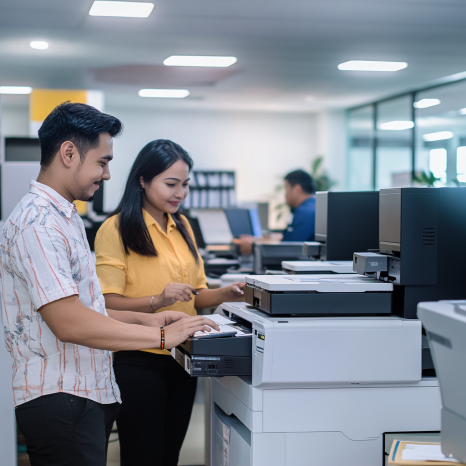Troubleshooting Event Printer Rentals

Events demand precision, speed, and reliability—especially when it comes to printing name tags, tickets, sign-in sheets, or marketing materials. However, even the most carefully planned event can experience hiccups with printing equipment. That’s why understanding the essentials of Troubleshooting Event Printer Rentals is key to ensuring everything goes according to plan.
Whether you’re organizing a corporate conference, a trade expo, or a product launch, this guide will walk you through common printer rental issues at events and how to resolve them effectively.
Why Reliable Event Printing Matters
Event printing is often time-sensitive. Attendees expect on-the-spot outputs for badges, QR codes, presentations, or receipts. A malfunctioning printer can delay registration, reduce professionalism, and create unnecessary stress.
Many organizers choose printer rentals for events due to convenience and cost-efficiency. But to make the most of this solution, knowing how to troubleshoot potential problems is crucial.
Common Issues in Event Printer Rentals
1. Printer Not Turning On
Cause: This usually stems from loose power cables, faulty outlets, or transport-related internal issues.
Troubleshooting Steps:
Check the power cable connection to both printer and wall outlet.
Use a different outlet or test with another device.
Ensure power switches are turned on.
Contact your rental provider if the issue persists.
2. Paper Jams
Cause: Improper paper loading, damaged sheets, or debris inside the printer.
Troubleshooting Steps:
Open all printer compartments and gently remove any stuck paper.
Check rollers for any remaining debris or residue.
Reload paper properly, making sure it’s aligned and not overfilled.
For event printing, especially high-volume tasks like ID badges or flyers, it’s advisable to use smooth, quality paper to minimize jamming.
3. Connectivity Issues (Wi-Fi or USB)
Cause: Misconfigured network settings or outdated drivers.
Troubleshooting Steps:
Restart the printer and connected devices.
Confirm that both printer and laptop/tablet are on the same network.
Update printer drivers (have a USB backup just in case).
Test USB cable connectivity as an alternative.
If using wireless printers, you might want to review Setting Up a Home Office Printer which includes simple setup instructions also applicable to temporary setups at events.
4. Low-Quality Print Output
Cause: Low ink/toner levels, incorrect print settings, or incompatible media.
Troubleshooting Steps:
Verify ink or toner levels; replace cartridges if needed.
Use printer settings that match the paper type.
Avoid using rough or non-recommended paper for graphic-heavy materials.
Do a printhead cleaning (available in printer settings).
5. Printer Queue Freezes or Delays
Cause: Too many documents sent at once or spooling issues.
Troubleshooting Steps:
Cancel all jobs and restart the print queue.
Restart both the printer and the sending device.
Use PDF format for large batches to reduce processing delays.
Preventive Measures for Smooth Printing
To minimize the chances of printer issues during your event, follow these best practices:
1. Test the Printer Before the Event
Ensure that all rental printers are tested before being deployed. If possible, request an early delivery from your provider so you can run a dry run.
2. Have Spare Supplies Ready
Always have extra paper, ink/toner, and cables. These are the most common consumables that run out or fail during high-traffic events.
3. Assign a Print Manager
Designate a tech-savvy staff member or ask your rental provider for onsite support to monitor the printer throughout the event.
4. Use Reliable Rental Providers
Work with companies that specialize in event printer rentals and offer technical support. If you’re hosting remote or hybrid events, you may also benefit from these tips:
Choosing the Right Printer for Your Event
Your choice of printer matters just as much as the troubleshooting strategy. Here are a few factors to consider:
Volume Needs: Thermal or laser printers are best for fast, bulk printing like badges or receipts.
Mobility: Portable wireless printers make sense for pop-up booths and traveling teams.
Print Type: Color vs. black-and-white depends on branding and visual needs.
Integration: Make sure the printer works seamlessly with your registration system or POS software.
Check out Portable Printers for Home Offices for ideas on compact solutions that can double as event printers.
When to Call for Technical Support
Even with all precautions, things can still go wrong. Don’t hesitate to contact your printer rental provider when:
The issue persists after basic troubleshooting
Error codes appear on the display
Print outputs are unreadable or incomplete
Printer is physically damaged in transit
A dependable provider like Marga Enterprises should have contingency plans and responsive support teams in place to handle such scenarios promptly.
Conclusion: Print with Confidence at Your Next Event
Mastering the art of Troubleshooting Event Printer Rentals ensures your event runs smoothly, your guests are satisfied, and your brand makes a great impression. Don’t leave your printing needs to chance—plan, test, and partner with a trusted provider.
Need help with event printer rentals and support? Connect with Marga Enterprises today.
Facebook Page: Marga Enterprises on Facebook
YouTube Channel: @MargaEnterprises24
Visit our website: https://marga.biz
Contact us: CP/Telephone – 09171642540, 09614481276, 027-216-9415
Let your event printing be the least of your worries—print smart, troubleshoot fast, and deliver with excellence.
